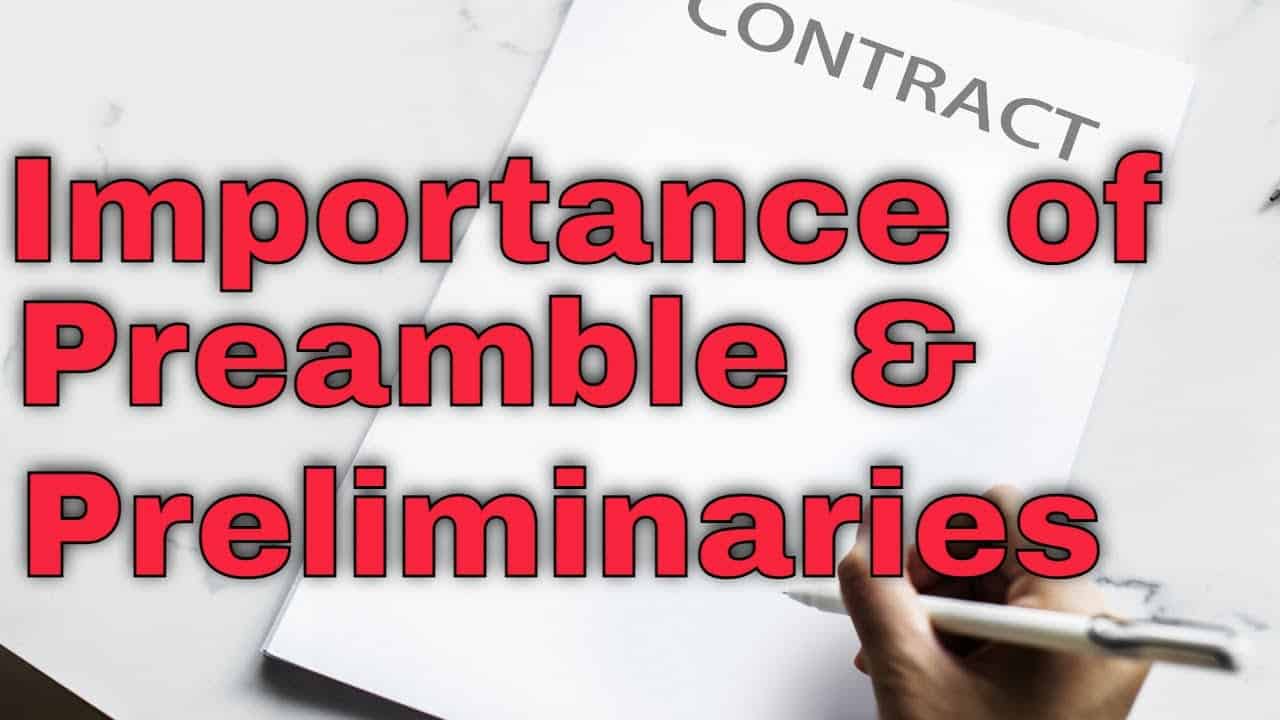

Preamble and Preliminaries are two very important terminologies of a Tender or Contract document, but do you know what they both actually stand for and what is the difference between Preamble and Preliminaries?
If not, please read this blog for details.
The preamble is a description of all documents that are normally populated during the preparation of the contract document such as contract specifications, cost estimates, bills of quantities and other clauses of contracts depending on the contract type. Preamble assists the reader to interpret the entire contract document.
A description of the following document is normally included within the preamble:
A preamble should be a crisp and short note. It should only include relevant points in a brief paragraph. Any further detail of clauses, caveats, exclusion, etc should be provided in the main document.
Bill of Quantities (BOQs) is one the most important document of a Tender or Contract Document. The preamble is the first section of a BOQ and it assists the reader to understand the unit price items and a high-level description of the Method of Measurement of those unit items.
It is observed that sometimes people get confused between preamble and preliminaries. However, there is a significant difference between the two. Please read this blog further to understand both in a concise manner.
Preliminaries are normally populated as part of the tender documents. It provides the project brief that assists the tenderer or contractor to assess the project and develop the cost of Preliminary Items and it is referred to as the “Preliminary Cost” of the project.
Preliminary also specifies the general condition of the project, sub-contractor clause, method of testing and approval process, etc. The cost of preliminary includes (but is not limited to) site setup, admin facilities, office equipment, H&S facilities, welfare facilities, plant, machinery, etc.
The Preliminaries of the Contract documents normally include
In simple terms, the main parts of construction work (also known as Permanent Works) are covered under design documents, specifications, standard details, and Bill of Quantities. The project overheads like project management, site welfare, individual items like testing, surveys, etc are documented under Preliminaries.
Read More:
The Preliminaries are normally covered in three parts:
In project Initiation, the site set-up, H&S, welfare facilities, permanent/ temporary site boundary fixing, etc are covered as unit price items
In running cost, the site-office daily expenses like electricity, broadband, canteen supplies, office maintenance, site vehicles, PPE, etc are covered as a weekly or monthly budget.
All the items that are essential during the handover process are covered in the Project Handover section and included as unit price items. The items are like removal of site, removal of temporary and permanent project boundaries, handover of health & safety file, etc.
When consultants prepare the contractor’s document, it is recommended that the quantity and rates of preliminaries are left blank and request tenderers to fill that information.
In a nutshell, the preliminaries should include all the items that are not explicit to the project work units, but they have their own recognizable cost. As a thumb rule, Preliminaries are normally in the range of 10-15% of the main work cost. During the tender preparation, it is very important to control and play around with the Preliminary sums to come up with the best possible tender price to win the contract.
A sub-contractor carries out specific tasks in a construction project. Sub-contractors are known for specialized skills such as topo survey, CCTV drainage survey, GI survey, etc. The Preliminary section of the sub-contractor should include their resource cost, their overheads along with their daily rates.
If there is an element of design activity or the specialized activity that item should also be included as the unit item cost. If the H&S or welfare facilities would be common between the main contractor and sub-contractor, then that cost should not be included within the subcontractor's preliminaries.

Preliminaries and Preambles both are very important sections of a contract or tender document, but they are not the same. Both cover an entirely different set of information.
The preamble is a brief description of key items of tender or contract document such as contract specifications, cost estimate, bills of quantities, etc. whereas Preliminaries covers the cost of those items that are not part main design package work but are considered as project overheads are priced as unit price items, as explained above.
I hope this blog enlightens you with some critical but important aspects of Preambles and Preliminaries.
Please feel free to share your comments.
Admin, gcelab.com Please see our Pillar Post to know why we founded gcelab.com.
Read More:

Founder at gcelab.com, Pooja is an Entrepreneur unlocking human potential. Working in the Principles of Lean Start-up, Pooja believes in Transparency and User Happiness the most. Pooja’s background in teaching gives her a sophisticated grasp on even the most tedious aspect of course building. She is passionate about people who believe that good is not enough.